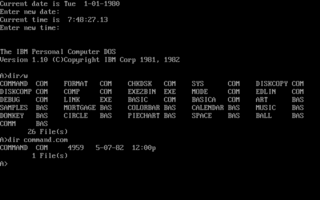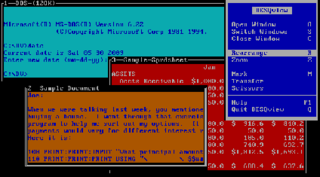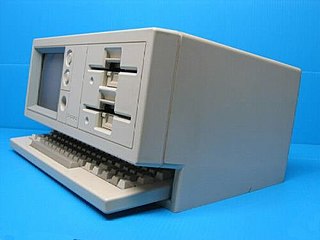Related Research Articles

WordStar is a word processor application for microcomputers. It dominated the market in the early and mid-1980s, succeeding the market leader Electric Pencil. It was published by MicroPro International, originally written for the CP/M-80 operating system, and later written also for MS-DOS and other 16-bit PC OSes. Seymour I. Rubinstein was the principal owner of the company, and Rob Barnaby was the sole author of the early versions of the program. Starting with WordStar 4.0, the program was built on new code written principally by Peter Mierau.
XyWrite is a word processor for MS-DOS and Windows modeled on the mainframe-based ATEX typesetting system. Popular with writers and editors for its speed and degree of customization, XyWrite was in its heyday the house word processor in many editorial offices, including the New York Times from 1989 to 1993. XyWrite was developed by David Erickson and marketed by XyQuest from 1982 through 1992, after which it was acquired by The Technology Group. The final version for MS-DOS was 4.18 (1993); for Windows, 4.13.

Xenix is a discontinued version of the Unix operating system for various microcomputer platforms, licensed by Microsoft from AT&T Corporation in the late 1970s. The Santa Cruz Operation (SCO) later acquired exclusive rights to the software, and eventually replaced it with SCO UNIX.

IBM PC DOS, an acronym for IBM Personal Computer Disk Operating System, is a discontinued disk operating system for IBM PC compatibles, manufactured and sold by IBM from the early 1980s into the 2000s. Developed by Microsoft, it was also sold by that company as MS-DOS. Versions of both operating systems remained identical or almost identical until 1993, when IBM began selling PC DOS 6.1 with new features.

CP/M-86 was a version of the CP/M operating system that Digital Research (DR) made for the Intel 8086 and Intel 8088. The system commands are the same as in CP/M-80. Executable files used the relocatable .CMD file format. Digital Research also produced a multi-user multitasking operating system compatible with CP/M-86, MP/M-86, which later evolved into Concurrent CP/M-86. When an emulator was added to provide PC DOS compatibility, the system was renamed Concurrent DOS, which later became Multiuser DOS, of which REAL/32 is the latest incarnation. The FlexOS, DOS Plus, and DR DOS families of operating systems started as derivations of Concurrent DOS as well.

DESQview (DV) is a text mode multitasking operating environment developed by Quarterdeck Office Systems which enjoyed modest popularity in the late 1980s and early 1990s. Running on top of DOS, it allows users to run multiple programs concurrently in multiple windows.
Columbia Data Products (CDP) is a company which produced the first legally reverse-engineered IBM PC clones. It faltered in that market after only a few years, and later reinvented itself as a software development company.

Compaq's first computers' form factors were portable, also called "luggables", and then "lunchbox computers", and together constituted the Compaq Portable series. These computers measured approximately 1 by 1 foot on the side, and were approximately 2+1⁄2 feet (0.76 m) wide. As the products evolved, laptops and notebooks were created offing a new level of portability that caused the market to explode.

The Compaq Portable is an early portable computer which was one of the first IBM PC compatible systems. It was Compaq Computer Corporation's first product, to be followed by others in the Compaq Portable series and later Compaq Deskpro series. It was not simply an 8088-CPU computer that ran a Microsoft DOS as a PC "work-alike", but contained a reverse-engineered BIOS, and a version of MS-DOS that was so similar to IBM's PC DOS that it ran nearly all its application software. The computer was also an early variation on the idea of an "all-in-one".

Multiuser DOS is a real-time multi-user multi-tasking operating system for IBM PC-compatible microcomputers.
Merge is a software system which allows a user to run DOS/Windows 3.1 on SCO UNIX, in an 8086 virtual machine.

The Hyperion is an early portable computer that vied with the Compaq Portable to be the first portable IBM PC compatible. It was marketed by Infotech Cie of Ottawa, a subsidiary of Bytec Management Corp., who acquired the designer and manufacturer Dynalogic in January 1983. In 1984 the design was licensed by Commodore International in a move that was forecast as a "radical shift of position" and a signal that Commodore would soon dominate the PC compatible market. Despite computers being "hand-assembled from kits" provided by Bytec and displayed alongside the Commodore 900 at a German trade show as their forthcoming first portable computer, it was never sold by Commodore and some analysts downplayed the pact. The Hyperion was shipped in January 1983 at C$4995, two months ahead of the Compaq Portable.

Phoenix Technologies Ltd is an American company that designs, develops and supports core system software for personal computers and other computing devices. The company's products – commonly referred to as BIOS or firmware – support and enable the compatibility, connectivity, security and management of the various components and technologies used in such devices. Phoenix Technologies and IBM developed the El Torito standard.
A disk compression software utility increases the amount of information that can be stored on a hard disk drive of given size. Unlike a file compression utility, which compresses only specified files—and which requires the user to designate the files to be compressed—an on-the-fly disk compression utility works automatically through resident software without the user needing to be aware of its existence. On-the-fly disk compression is therefore also known as transparent, real-time or online disk compression.
Microcom, Inc. was a major modem vendor during the 1980s, although never as popular as the "big three", Hayes, U.S. Robotics (USR) and Telebit. Nevertheless, Microcom holds an important place in modem history for introducing the MNP error-correction and compression protocols, which were widely used under license by most modem manufacturers in the 1990s. The company went public in 1987. Compaq purchased publicly outstanding shares of the company in 1997.
This article presents a timeline of events in the history of 16-bit x86 DOS-family disk operating systems from 1980 to 2020. Non-x86 operating systems named "DOS" are not part of the scope of this timeline.
Edos is a discontinued operating system based upon IBM's original mainframe DOS. The name stood for extended disk operating system.

The Olivetti M24 is a computer that was sold by Olivetti in 1983 using the Intel 8086 CPU.
MS-DOS is an operating system for x86-based personal computers mostly developed by Microsoft. Collectively, MS-DOS, its rebranding as IBM PC DOS, and few operating systems attempting to be compatible with MS-DOS, are sometimes referred to as "DOS". MS-DOS was the main operating system for IBM PC compatibles during the 1980s, from which point it was gradually superseded by operating systems offering a graphical user interface (GUI), in various generations of the graphical Microsoft Windows operating system.
VM/386 is a multitasking operating system or 'control program' that took early advantage of the capabilities of Intel's 386 processor. By utilizing Virtual 8086 mode, users were able to run their existing text-based and graphical DOS software in safely separate environments. The system offered a high degree of control, with the ability to set memory limits, CPU usage and scheduling parameters, device assignments, and interrupt priorities through a virtual machine manager menu. Unique CONFIG.SYS and AUTOEXEC.BAT files could be configured for each application, and even different DOS versions. In 1991 the vendor announced intentions to support DPMI 1.0 in VM/386.
References
- ↑ "Guide to the Stephen M. Cabrinety Collection". 1991.
- ↑ "Object orientation".
- ↑ version 5.0, 1988 "Carbon Copy Plus Version 5.0". PC Magazine .
- ↑ Erik Sandberg-Diment (August 11, 1987). "Personal computers, remote control". The New York Times .
- ↑ "Carbon Copy Plus". Computerworld . August 3, 1987.
- ↑ "Extra Bonus for users of the IBM PC and new HP Portable Vectra" (PDF). The Portable Paper. Hewlett-Packard. November 1987. p. 11.
Included with the WorldPort 2400 at no charge is ...
- ↑ "Microcom acquires Carbon Copy Plus developer Meridian Technology". InfoWorld . February 22, 1988. p. 17.
- ↑ Larry Luxner (January 26, 1989). "Tax Benefits, Low Labor Costs lure Microcom to Puerto Rico".
the third U.S. software manufacturer to select Puerto Rico as a production site for the booming U.S. software market.
- ↑ "David Iannini, Senior Team, William & Harris Associates". Mergr.com.
United Kingdom .. acquisitions of Meridian Technology and Carbon Copy Ltd. by Microcom
- ↑ "Carbon Plus 3.0". Computerworld . September 1, 1986. p. 78.
- ↑ "Meridian Technology: Carbon Copy Plus". Computerworld . March 30, 1987. p. 50.
- ↑ Elisabeth Horwitt (June 26, 1989). "Remote access: Carbon Copy Plus". Computerworld . p. 12.
- ↑ "IBM DOS Version 5.00 and Upgrade". June 11, 1991.
- ↑ {{cite web Carbon Copy Mac was also made available, with version 1.0 being released in 1990, and version 2.0 being released in 1991. It was however not compatible with PC editions of Carbon Copy. Carbon Copy Mac largely competed with Farallon's Timbuktu versions 3 and 4 on the Macintosh platform. |url=https://www-01.ibm.com/common/ssi/cgi-bin/ssialias?appname=skmwww&htmlfid=897%2FENUS694-014&infotype=AN&subtype=CA&mhsrc=ibmsearch_a&mhq=%20Coinbase%20Pro-customer-service-%2B1888-666-0576-Coinbase%20Pro-customer-support-number-Latest%20chhh |title=Announcement Number: 694-014 |date=May 10, 1994}}